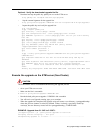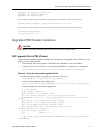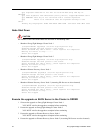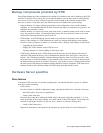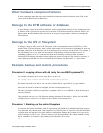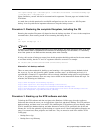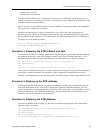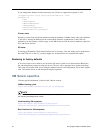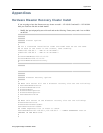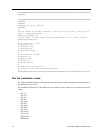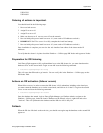
26 EncrypTight Manager Installation Guide
Backup components provided by ETM
EncrypTight Manager provides mechanisms for backing up its database, and also for backing up the ETM
software. Customers who do not do full server backups regularly can use those tools to ensure that they
can recover as close to a point of failure as possible, while backing up the minimal amount of data
necessary to restore. Using these tools also reduces the need for frequent full system backups.
• Database Backup: To capture a known good point in time configuration, users can take database
snapshots. It is recommended that this be done each time they deploy a production set of policies, at a
minimum. See procedure 5 below.
• Database Restore: To restore to a known good point in time, a database backup can be used to restore
from. See procedure 6 below. If restoring an entire cluster, this only needs to be done on one node,
and then the other node should be sync'd via the UI.
• ETM Backup: A full ETM backup does not need to be performed as frequently as the database
backup, as the changes to a ETM distribution are much less frequent than changes to the database.
However, whenever changes are made, it is advisable to take a backup. Such changes would include:
• Upgrading the ETM software
• Staging new ETEP software on the ETM ftp server
• Topology changes to a cluster (adding or removing a node)
• ETM Restore: Restoring from a ETM backup would be necessary if some damage had occurred
within the ETM install directories, such as unintentional deletion of the policyserver config files or
binaries. The ETM backup includes a database backup within the archive (tar file), however, it may
not be necessary to restore the database. If the intention of the restore is to simply fix the filesystem,
the database does not need to be restored. If, however, a full system recovery is being performed, then
the most recent ETM backup and database backup should be used for restoration. If the most recent
database backup is that contained within the ETM backup, then that should be used.
Hardware Server specifics
Drive failures
A hardware ETM server has two possible configurations: a non-RAID dual drive system, or a RAID 1
dual drive system (mirroring).
• RAID system
For a drive failure in a RAID configuration, simply replacing the failed drive is all that is necessary.
• non-RAID system. There are two possibilities:
• Failure of the main drive
Boot from the backup drive (change the BIOS order), and restore with either procedure 2., 4., or 6.
below, depending on how many changes were made outside of the ETM software. Then replace the
failed drive and dd the main drive to the new drive, which is now the new backup drive.
• Failure of the backup drive
Replace the backup drive and repeat the dd operation to copy the main drive to the backup drive



